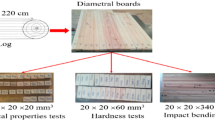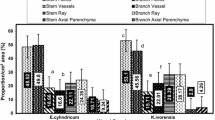Abstract
Key message
The higher the basic density and the lignin content, the higher the cleavage strength tends to be and the less prone to checking the wood tend to be.
Abstract
The checks that often affect Eucalyptus wood, also called cracks or cleavages, depreciate the material and cause considerable loss of yield in higher value-added products for the sawn wood industry. Information about the influence of basic density and lignin content on the propensity of wood to checks, simulated in a cleavage mechanical test, is scarce in the literature. Therefore, the objective of this work was to investigate and clarify the relationships between the cleavage strength and the basic density and lignin content of the wood within the stem. For this, two Eucalyptus grandis trees were felled at 22 years of age and the stems were sectioned to obtain the base logs, three meters long, which were used during the analysis made in the present research. From these logs, specimens for the cleavage test were made. After the cleavage test, the basic density and lignin content were determined for each specimen, aiming at adjusting regression models that explained the variation of the cleavage strength of the wood as a function of the aforementioned properties. The results showed that the higher the basic density and the lignin content, the higher the cleavage strength tends to be and, consequently, the less prone the wood tend to be to the checks.

Adapted from Bodig and Jayne 1982)



Adapted from ASTM D143 standard (ASTM 2014)



Similar content being viewed by others
Data availability
Data are available in the repository archive.materialscloud.org, identified by https://doi.org/10.24435/materialscloud:g0-br.
References
ABCP M3/69 (1974) Test methods. Associação Brasileira Técnica de Celulose e Papel, São Paulo
ASTM D143-14 (2014) Standard test methods for small clear specimens of timber. American Society for Testing and Methods, West Conshohoken
Araújo HJB (2007) Functional relationships among physical and mechanical properties of Brazilian tropical woods. Floresta 37:399–416. https://doi.org/10.5380/rf.v37i3.9937
Balboni BM, Batista AS, Rodrigues RA, Garcia JN (2020) Relationship between strength and density in juvenile and mature Eucalyptus sp. wood. Braz J Anim Environ Res 3:983–991. https://doi.org/10.34188/bjaerv3n3-019
Barotto AJ, Monteoliva S, Gyenge J, Martinez-Meier A, Moreno K, Tesón N, Fernández ME (2017) Wood density and anatomy of three Eucalyptus species: implications on hydraulic conductivity. For Syst 26:11–21. https://doi.org/10.5424/fs/2017261-10446
Bodig J, Jayne BA (1982) Mechanics of wood and wood composites. V. N. Reinhold, New York
Déjardin A, Laurans F, Arnaud D, Breton C, Pilate G, Leplé J (2010) Wood formation in angiosperms. CR Biol 333:325–334. https://doi.org/10.1016/j.crvi.2010.01.010
Dias FM, Lahr FAR (2004) Strength and stiffness properties of wood esteemed through the specific gravity. Sci For 65: 102–113. https://www.ipef.br/publicacoes/scientia/nr65/cap10.pdf. Accessed 22 Jan 2019
Donaldson LA (2001) Lignification and lignin topochemistry—an ultrastructural view. Phytochemistry 57:859–873. https://doi.org/10.1016/S0031-9422(01)00049-8
Downes GM, Hudson IL, Raymond CA, Dean GH, Michell AJ, Schimleck LR, Evans R, Muneri A (1997) Sampling plantation Eucalypts for wood and fibre properties. CSIRO, Melbourne
Feffer D, Piva HL, Hartung P, Fonseca Jr. JC, Correa C, Lacerda T, Silva R, Toledo G (2020) Report Ibá 2020. Brazilian Tree Industry. https://iba.org/datafiles/publicacoes/relatorios/relatorio-iba-2020.pdf. Accessed 8 Mar 2021
Gacitúa W, Ballerini A, Lasserre JP, Bahr D (2007) Nanoindentations and ultrastructure in Eucalyptus nitens with micro and mesocracks. Maderas Ciencia y Tecnología 9:259–270. https://doi.org/10.4067/S0718-221X2007000300006
Galvão APM, Jankowsky IP (1985) Secagem racional da madeira. Nobel, São Paulo
Goldschimid O (1971) Ultraviolet spectra. In: Sarkanen KV, Ludwig CH (eds) Lignins: occurrence, formation, structure and reactions. Wiley, New York, pp 241–266
Gomide JL, Demuner BJ (1986) Determinação do teor de lignina em material lenhoso: método Klason modificado. O Papel 47:36–38
Gonçalves FG, Oliveira JTS, Della Lucia RM, Nappo ME, Sartório RC (2009) Specific density and dimensional variation of a Eucalyptus urophylla x Eucalyptus grandis clonal hybrid. R Árvore 33:277–288. https://doi.org/10.1590/S0100-67622009000200009
Grabner M, Cherubini P, Rozenberg P, Hannrup B (2006) Summer drought and low earlywood density induce intra-annual radial cracks in conifers. Scand J for Res 21:151–157. https://doi.org/10.1080/02827580600642100
Hillis WE, Brown AG (1978) Eucalypts for wood production. CSIRO, Melbourne
Kollmann FFP, Côté WA (1968) Principles of wood science and technology: solid wood. Springer-Verlag, New York
Mattheck C, Kubler H (1995) Wood: the internal optimization of trees. Springer-Verlag, New York
Meshitsuka G, Lee ZZ, Nakano J, Eda S (1982) Studies on the nature of lignin-carbohydrate bonding. J Wood Chem Technol 2:251–267. https://doi.org/10.1080/02773818208085134
Morais PHD, Longue D Jr, Colodette JL, Morais EHC, Jardim CM (2017) Influence of clone harvesting age of Eucalyptus grandis and hybrids of Eucalyptus grandis x Eucalyptus urophylla in the wood chemical composition and in kraft pulpability. Ciência Florestal 27:237–248. https://doi.org/10.5902/1980509826462
NBR 11941–02 (2003) Wood—determination of basic density. Associação Brasileira de Normas Técnicas, Rio de Janeiro
Nogueira MCJA, Almeida DH, Araujo VA, Vasconcelos JS, Christoforo AL, Almeida TH, Lahr FAR (2019a) Physical and mechanical properties of Eucalyptus saligna for timber structures. Ambiente Construído 19:233–239. https://doi.org/10.1590/s1678-86212019000200319
Nogueira MCJA, Araujo VA, Vasconcelos JS, Prataviera F, Vasconcelos JCS, Cruz JN, Christoforo AL, Lahr FAR (2019b) Physical and mechanical properties of Eucalyptus alba wood for civil construction. Ciência da Madeira 10:71–77. https://doi.org/10.12953/2177-6830/rcm.v10n1p71-77
Nogueira MCJA, Araujo VA, Vasconcelos JS, Vasconcelos JN, Christoforo AL, Lahr FAR (2020) Sixteen properties of Eucalyptus tereticornis wood for structural uses. Biosci J 36:449–457. https://doi.org/10.34062/afs.v7i4.10882
Pelozzi MMA, Severo ETD, Calonego FW, Rodrigues PLM (2012) Physical properties of the juvenile and mature wood of Pinus elliottii Engelm var. elliottii and Eucalyptus grandis Hill ex Maiden. Ciência Florestal 22:305–313. https://doi.org/10.5902/198050985737
Rowell RM (2005) Handbook of wood chemistry and wood composites, 1st edn. CRC Press, Madison
Silva JC, Matos JLM, Oliveira JTS, Evangelista WV (2005) Influence of age and position along the trunk on the chemical composition of Eucalyptus grandis Hill ex. Maiden Wood Árvore 29:455–460. https://doi.org/10.1590/S0100-67622005000300013
Soares BCD, Lima JT, Goulart SL, Assis CO (2019) Strength and stiffness of the reaction wood in five Eucalyptus species. Holzforschung 73:219–222. https://doi.org/10.1515/hf-2018-0091
Valenzuela P, Bustos C, Lasserre JP, Gacitúa W (2012) Fracture in Eucalyptus nitens wood: effect of nanomechanical properties, ultrastructure and anatomical level. Maderas Ciencia y Tecnología 14:225–238. https://doi.org/10.4067/S0718-221X2012000200009
Funding
This study was supported by Conselho Nacional de Desenvolvimento Científico e Tecnológico (CNPq) and Coordenação de Aperfeiçoamento de Pessoal de Nível Superior (CAPES).
Author information
Authors and Affiliations
Contributions
All the authors have accepted responsibility for the entire content of this submitted manuscript and approved submission.
Corresponding author
Ethics declarations
Conflict of interest
On behalf of all authors, the corresponding author states that there is no conflict of interest.
Additional information
Communicated by Ingo Burgert.
Publisher's Note
Springer Nature remains neutral with regard to jurisdictional claims in published maps and institutional affiliations.
Rights and permissions
About this article
Cite this article
Soares, B.C.D., Lima, J.T. & de Assis, C.O. Influence of density and lignin content on cleavage strength of Eucalyptus grandis wood. Trees 36, 1185–1192 (2022). https://doi.org/10.1007/s00468-022-02279-z
Received:
Accepted:
Published:
Issue Date:
DOI: https://doi.org/10.1007/s00468-022-02279-z




